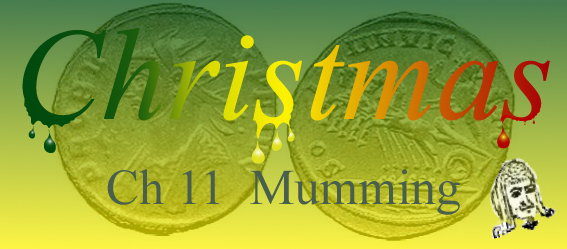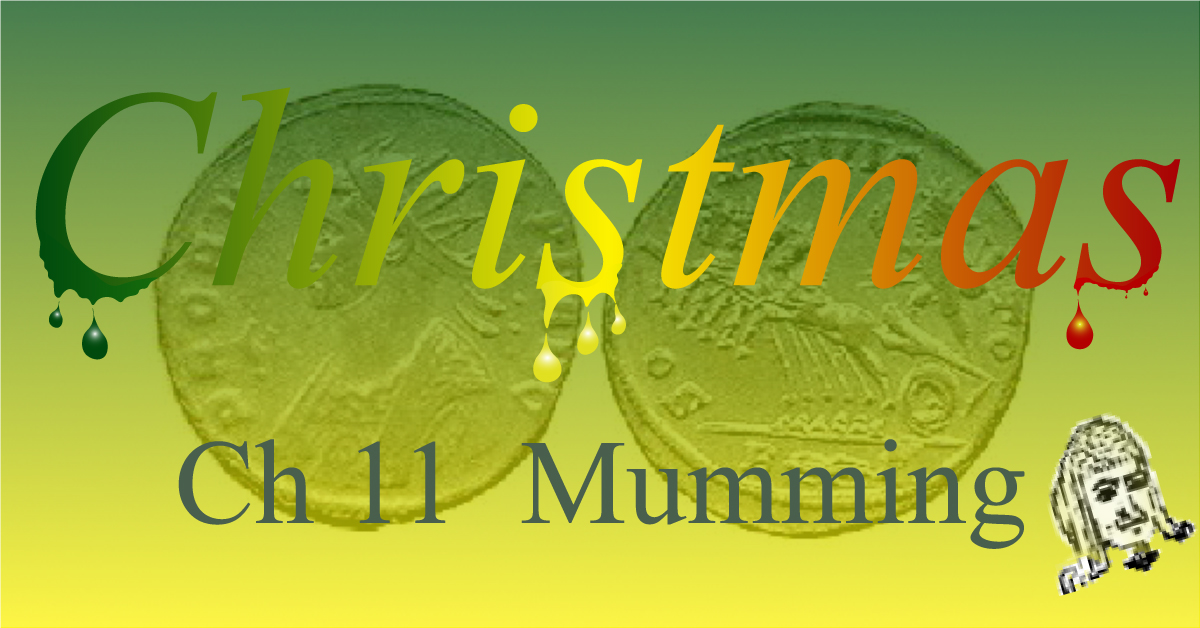Many Americans may be unfamiliar with mumming as it is declining in popularity.
However, there are a few places in the United States where people still engage in the practice, so a chapter is devoted to it here. Mumming is a type of play where the participants act out a series of scenes in which a person is killed and then brought back to life by a doctor using a magic potion. The people dress up in costumes and usually wear masks or makeup. Sometimes the performance is held in situ. Other times the performers move through the streets and may go house to house. In some cultures, there is a game made of trying to guess who is hiding behind the costume and mask. The plays are sometimes performed without sound, and in other forms, the participants disguise their voices in various ways such as by speaking while inhaling. One can easily see the connection to wassailing in this ritual. Of course, many Christians have condemned and avoided this practice throughout the centuries. The act of pretending to raise the dead through the use of some sort of magic potion violates the Christian walk in obvious fashion — blatant blasphemy. Pretending to take on the powers of God has always been seen as blasphemy, and rightly so. The Bible verse most often used to define blasphemy is John 10:33.
Joh 10:33 The Jews answered him, saying, For a good work we stone thee not; but for blasphemy; and because that thou, being a man, makest thyself God.
This verse gives the Christian plenty of reason to shy away from the practice of mumming without further study. However, we will still examine the connection to the festivities of Saturnalia and other pagan rituals. Mumming is sometimes called masking. Some of the experts, such as Mr. Miles, trace the English custom of mumming to the time of Edward III in the middle of the fourteenth century.
However, the actual origins of mumming or masking go back to a time well before the reign of King Edward III, which Mr. Miles also states. There also appears to be a connection between mumming and religious rituals which involved the wearing of animal heads and skins. This was, in times past, a practice engaged in by societies around the globe. The practice of mumming has roots in a wide variety of pagan rituals. However, the focus here will be on its connection to the Saturnalia.
The Saturnalia, written by Macrobius, tells us there were certain types of behavior which were avoided during the Saturnalia. This was at least true among those who considered themselves more refined than the masses. There are numerous condemnations of the comic stage, singing, and dancing throughout Macrobius' Saturnalia, not only at the Saturnalia, but also as a general rule. The participants of the discourse described in these books take pride in holding themselves to a higher standard than the commoners. For example, one of the characters named Praetextatus asserts the pleasures of the comic stage are not in keeping with his gods and should not be introduced into so serious a gathering (Macrobius vol. I 323). The characters in the book allude to the fact most people engage in a more informal and riotous celebration than they do.
The statement above points to the board games and noisy dinner celebrations engaged in by those who were viewed as less sophisticated. The character's comments often take on a snobbish tone throughout the books. There is, however, a benefit in the holier-than-thou attitudes embraced by the characters. It illuminates the differences between the more refined celebration in which the characters are engaged and the celebrations the masses would have been engaged in just outside their doors. This next quote shows there were some sort of performances going on.
The "barefoot dancer and the coarse clown" mentioned here would be indicative of events normally associated with the Saturnalia. This is illustrated in the next quote from a work of the same title but authored by Lucian. Lucian's words are written from Saturn's point of view.
Most descriptions of the Saturnalia paint a picture of rambunctious raillery and sexual debauchery. Most businesses were closed, and most people were not required to work. Still, there were exceptions then like there are exceptions today. The mention of composing and delivering discourse in the following quote, combined with the dancing and clowning mentioned above, shows the theatrical stage was part of the festivities.

There were theatrical performances at the Saturnalia. These theatrical performances, combined with the tradition of wassailing, connect mumming to the Saturnalia.
We have all heard the expression "a picture is worth a thousand words." The picture we have from the Chronography of 354 calendar for the month of December realizes the truth of that expression. Not only does the image depict the throwing of dice, which was a common Saturnalian activity, but it also depicts a mask which was a symbol of theatrical performances. This mask also had a deeper meaning which we will get to in a moment. The mask is identified by a red arrow here.
From very early on, there has been some sort of masking or guising associated with the Saturnalia. Martial, who wrote during the first century, recorded a German mask as number 176 on his list of presents made to guests at the feasts.
I am the fancy of the potter, the mask of a red-haired Batavian. This countenance, at which you smile, is an object of terror to children" (Martial 626).
Here, the mask is described as "an object of terror to children" for good reason. The origin of the mask at the Saturnalia likely has less to do with the theater and more to do with a much darker side of Saturnian worship: human sacrifice. We will examine this topic in more detail in a further chapter. For now, this quote from Macrobius shows human sacrifices were replaced by the use of masks.
. . . and heads to Hades, and send a man [phôta] to the father,
they say that Hercules, returning through Italy with Geryon's cattle, persuaded their descendants to replace those ill-omened sacrifices with favorable ones, offering to Dis [Hades/Pluto] not human heads but masks with skillfully fashioned human faces and honoring Saturn's altar not by slaughtering a man but by kindling lights—for phôta means not only 'man' but also 'lights'" (Macrobius vol. I 81).
The situation is all the more serious because the mumming ritual is acted out on the supposed birthday of Christ who is truly able to resurrect the dead.
The masks at the Saturnalia were more commonly known by the Latin name oscilla. The masks used in the ritual of mumming are likely a replacement for human sacrifice. Throughout paganism, many have believed the blood, hide, or head of a sacrificial victim was "holy" and could somehow pass a blessing on to those who came into contact with them. There may also be a connection to medicine masks which are carved out of trees. In the case of medicine masks, the blessing or healing abilities of a "sacred" tree are passed on through a mask carved from that tree. The belief some sort of blessing can be passed from an object to a person leads back to the practice of carrying objects through the streets or even going house to house with so-called sacred items. In an above quote, Mr. Miles tells us the practice of mumming or masking was the attempt of a "band of worshipers clad in this uncouth but auspicious garb to bring good luck to a house." The supposed power behind this practice lies in the mask which, we have seen, would have derived its "power" because it represented the head of a person who was a victim of sacrifice.
There is no benefit for the Christian to engage in these types of practices. We are not called to put on a mask or disguise which originated from such a dark origin. We are called to "put on the new man, which is renewed in knowledge after the image" of our Creator.
Col 3:10 And have put on the new man, which is renewed in knowledge after the image of him that created him:
We are called to glorify God not to connect our worship of Him to these dark pagan rituals. The mumming ritual glorifies the mask and a magical potion which supposedly has the power to resurrect the dead. The situation is all the more serious because the mumming ritual is acted out on the supposed birthday of Christ who is truly able to resurrect the dead. The first chapter of Romans tells us, after we know God, we should not fall back into the ways of the world by connecting the worship of our incorruptible God with things of a pagan nature.
Rom 1:21 Because that, when they knew God, they glorified him not as God, neither were thankful; but became vain in their imaginations, and their foolish heart was darkened.
Rom 1:22 Professing themselves to be wise, they became fools,
Rom 1:23 And changed the glory of the uncorruptible God into an image made like to corruptible man, and to birds, and fourfooted beasts, and creeping things..
Rom 1:24 Wherefore God also gave them up to uncleanness through the lusts of their own hearts, to dishonour their own bodies between themselves:
Those who drape their bodies in pagan costume do indeed dishonor their own bodies.
Should Mumming Be Part of the Christian Walk?
1. The mumming ritual is blasphemous, whereby a person wearing a mask pretends to take on the powers of God.
2. Mumming or masking is likely derived from human sacrifice.
3. Mumming is also derived from plant worship.
3. The mumming ritual glorifies the mask and a magical potion which supposedly has the power to resurrect the dead.
4. This ritual attempts to make a mockery of Christ because it is acted out on the supposed birthday of Christ who is truly able to resurrect the dead.
Mumming is derived from a very dark place. Could the traditions concerning lights originate from a brighter source?








